
Mohit Maheshwari, founder and CEO, NMG Technologies
What did you do when you found the product you’ve always wanted but it’s out of stock?
Probably disappointed? Or maybe looked for options to get it somehow? What if there isn’t any option.
The disappointment is already there, but it also makes you lose the trust on that particular website.
Imagine the revenue you could lose when a customer leaves your site after they land on a page for an out-of-stock product.
You put in all the efforts, and most likely a good bit of spending on marketing, to get them to show up in the first place. Don’t waste it by having them leave. Rather, you can make tour visitors stay and make a purchase close to what they want or pay in advance for what they came for.
Before discussing how to save sells when products are out of stock, let’s recap what currently goes on in the market when it comes to committing mistakes…
- Being redirected to the product category without explanation.
- Getting slapped with a 404.
- Being redirected to a similar product without explanation.
Some e-commerce sites will even remove the out-of-stock products from navigation, but leave the page active for anyone who might find it via search, a bookmark, etc.
When you’re really not expecting an out of stock page, you end up with vague…
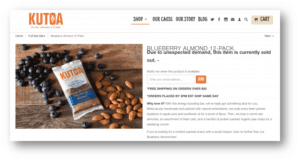
Vaguer…
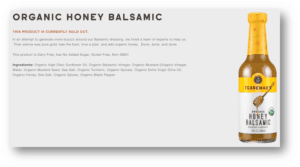
And just plain frustrating…
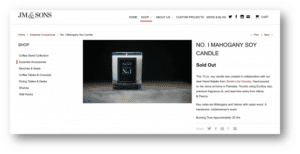
The Key flaws of an Out of Stock Product Page
1. User Experience (UX)
Whenever there is disappointment and frustration, UX comes into play. And the out of stock pages carry a potential disappointment and frustration.
Let’s look at some scenarios again…
- Realizing something is out of stock only after you’re ready to buy and reading the fine print. Bad UX, disappointed potential customer.
- Being redirected to the product category without explanation. Bad UX, disappointed potential customer.
- Getting slapped with a 404. Bad UX, disappointed potential customer.
- Being redirected to a similar product without explanation. Bad UX, disappointed potential customer.
Not even Waffles can save you…
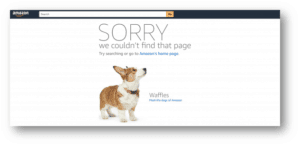
you want to limit the frustration and disappointment as much as possible, when creating out of stock product pages. At the core, that means…
- Communicating quickly.
- Communicating clearly.
- Offering a new, relevant direction.
2. SEO
Your way of handling out of stock pages will affect your rankings.
- If you leave a bunch of 404s around, you’ll be telling Google your site has errors and you’ll be wasting your crawl allowance.
- With a 404, link equity is totally lost.
- If your site isn’t particularly well-constructed, using 301 redirects might hurt the performance of your site. Again, not a good signal to send Google.
- If you leave the pages as is, you’ll be wasting your crawl allowance and be telling Google your content isn’t very fresh.
Pages discovered through organic search are especially damaging.
3. Sales
Of course, out-of-stock product pages result in lost sales.
Not every visitor is going to buy, but a handful of them would’ve if the stock was available.
The best possible route to save some of these lost sales. That might be…
- Offering to notify them when the product is back in stock.
- Suggesting similar or related items.
- Offering a discount on products in that category.
How to Optimize your Temporarily Out-of-Stock Product Pages
You should start experimenting. Conduct research for conversions, note down your ideas, prioritize them, test them, analyze them, repeat.
But here are a few things to watch-out for during that conversion research process.
1. Are you being as clear as possible?
Be concise and clear in explaining why the product is out of stock and approximately when it’ll be back in stock.
It should be something like…
- Seasonality
- Unexpected demand.
- Manufacturing issues.
It may be difficult for you to explain exactly when you’ll be back in stock, but do your best. The more specific you can be, the better.
Here’s an example from Hammock Town, which addresses another issue…
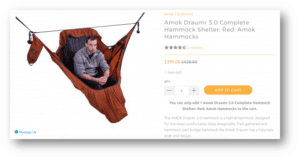
You can see that stock is clearly marked (“1 item left”) and I’m unable to add more what’s available.
Clarity is really important when it comes to out of stock (and even soon-to-be out of stock) product pages.
2. Don’t wait too long to announce it’s out of stock?
When a visitor is arriving at the product page through your site search or navigation, it’s possible to warn ahead that the item is out of stock. That way, the user doesn’t make it all the way through to the product page only to be disappointed.
Here’s an example from East Coast Lifestyle…
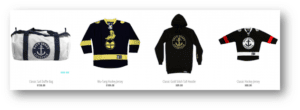
Great brand, but there isn’t much information around this “SOLD OUT” warning. First of all, it’s incredibly easy to miss. Second, it looks more like their “ON SALE” indicator…
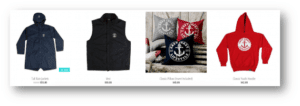 3. Are you confusing with the size stock?
3. Are you confusing with the size stock?
Let’s say you’re selling iPhone cases. If you’re out of the style for iPhone X, most visitors won’t know until they get to the product page and choose their desired size.
This can be frustrating, especially when they’re likely selecting a size with intent to buy.
Here’s an example from a clothing company…
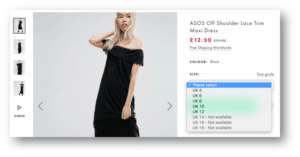
By the time they click on the size drop down, women have probably been through the product images, the product details, the size guide, etc. They’re ready to add to cart, but sadly… if you’re UK 14 and above, you’ve just wasted time and probable disappointed at this point.
4. Are you suggesting similar or related products?
If you don’t have the product your visitor wants in stock, why throw away the sales opportunity? Instead, consider redirecting your user towards products that will keep them happy.
Here’s how eBay does it…
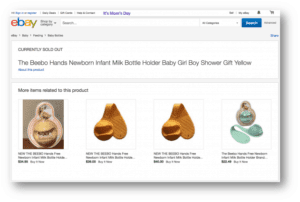
Notice they’re showing the same brand, but only slightly different products. These are highly likely to be “second best” options and will always have the potential of a sale.
When you scroll down, more options are available…
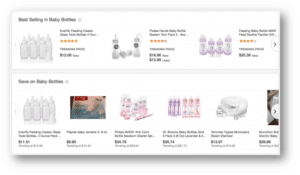
If eBay didn’t get it right the first time with the related products, then best-selling products in the same category or discounted products in the same category will do the trick.
But here are some things to consider…
- Presenting too many options can be overwhelming and presenting too few options can be underwhelming.
- How do your visitors shop most commonly? By brand? By product category? By color? By price? Direct based on that.
- What do people who view this product, but don’t purchase it commonly end up buying? Direct based on that.
- If the products you’re suggesting are more expensive than the originally desired product, consider offering a discount or bonus to keep the sale alive.
5. Are you capturing their contact info?
Instead of redirecting them to other product pages, especially when something is out of stock, always consider capturing their contact info.
Most commonly, this done by promising to inform the visitor when the item is back in stock. Like the one below.
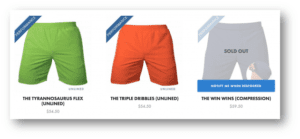 The visitor can submit his email right here hassle free…
The visitor can submit his email right here hassle free…
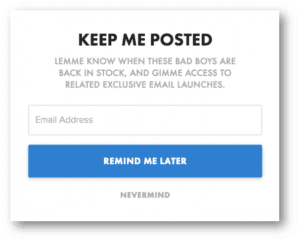 6. Are you showing in-store availability?
6. Are you showing in-store availability?
If you’re a small e-commerce site or don’t have brick-and-mortar stores, you can feel free to skip this section.
Look how BestBuy clearly shows online and in-store availability, even before the product page…
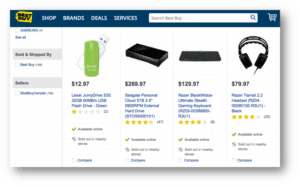
If something is unavailable online, but I know it’s available in-store just a mile away, it’s obvious that I’ll be willing to hop in the car, right?
Similarly, you might just be on the BestBuy and you see that the product is sold out in nearby stores, it’s obvious that you’ll be willing to buy online.
Chapters does something similar on their product pages…
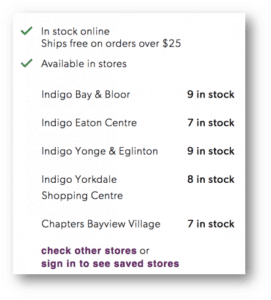
The specificity everything useful (e.g. “9 in stock” and “Ships free on orders over $25”).
You’ve seen the data. Most people that are disappointed by your stock will leave and buy somewhere else (or not at all). You’re on top when you can provide more options.
How do you Optimize Permanently Out-of-Stock Product Pages?
So far, we’ve been discussing products that are out of stock, but will return. But what if the product is discontinued, gone, never coming back?
Should you really use 404?
Yes, if you have a mid-size site and the product is gone forever, you can consider using 404.
What about 301 redirects, instead?
You need to be creative about redirecting, it has to be relevant. You don’t want the disappoint your customers. Home page and category page are not at all ideal.
Explain why they’re being redirected and to where.
Conclusion
Out-of-stock product pages do not really represent angry crowds and piles of burning money. Here’s what you need to know…
- How well you handle out-of-stock product pages impacts user experience, SEO and sales.
- If the product is only temporarily out of stock, ask yourself these questions during conversion research:
- Are you being as clear as possible?
- Are you waiting too long to announce it’s out of stock?
- Is your size stock confusing?
- Are you suggesting similar or related products?
- Are you capturing their contact info?
- Are you showing in-store availability?
If the product is permanently out of stock, you can always leave the page (with relevant suggestions added), have it (custom) 404, have it 301 (with dynamically generated messages), or use an “unavailable after” that tells search engines that a page will expire after a certain date.
NMG Technologies is an IT outsourcing company that provides web, mobile, cloud and marketing services to retailers and agencies.
Favorite